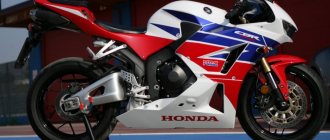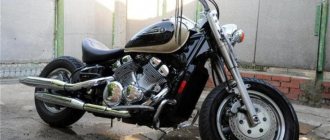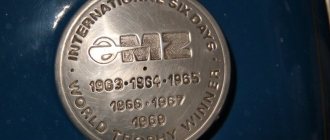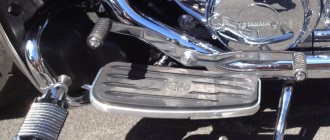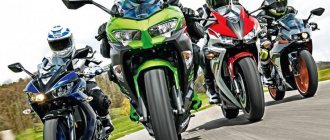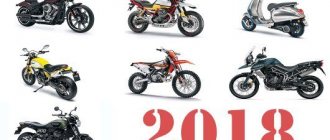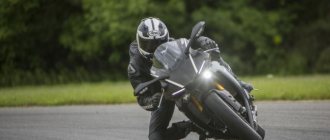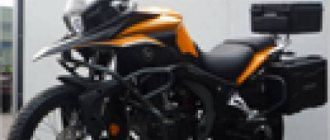000_moto_0711_012
Royal Enfield Classic 500: classic, 2011, 499 cm³, 27.2 hp, 187 kg, RUB 285,000.
Royal Enfield Classic 500: classic, 2011, 499 cm³, 27.2 hp, 187 kg, RUB 285,000.
And I don’t care that within the walls on Sofya Perovskaya there is no longer a squat, but “elite housing”, on the lawn by the fountain opposite you can no longer gut the Belomorina, and the street itself is now called Malaya Konyushennaya. St. Petersburg is full of places untouched by the remake - where we will go for a ride. “We” is me and the old-schooler, green as spring grass. Expanded and revised edition of the cult “Goa Racer”.
The rework, I tell you, is significant. The chassis components have remained almost unchanged, flat wings and a “frog” saddle (the destiny of the Classic version, specially designed for Europe - and, by the way, by British designers) make the device even more old-school. But the “mechanical traction”... A completely new power unit is the main difference from the “bullitas” and “machismos”, who live in varying degrees of murder in the hippie-trance paradise. Monoblock (goodbye, separate box with a switch on the right), with an aluminum cylinder, but still old-school (not counting injection, electric starter and nickel-silver cylinder), the development of the Austrian AVL promises to get rid of the plots from “Zen and the art of motorcycle care”.
Externally, the device can be identified as something between the Izh-49 and M-72, only significantly more compact than both of them (the base is only 1370!). And more elegant: the British have always known a lot about style. And the Austrians are also not Mashki-s-Aprashki: this engine will be even more beautiful than the original one, causing tenderness among both the former “oppositors” and the former owners of the “Old Javs”. It's a pity that instead of an ammeter there is now a fuel level lamp. Practical, but no longer brings a nostalgic tear. Just like the sound of an aluminum cylinder, devoid of the noble “cast iron” note.
But - snot aside. We roll out of the industrial zone in the south of St. Petersburg and drive to Komendantsky, the northern outskirts (beyond that there are only residential areas, which I refuse to recognize as Leningrad). The first kilometers on the broken asphalt were pleasing: the suspensions worked as they should, without Asian “biting” and Soviet oakness, “swallowing” unevenness with the stoicism of a pioneer hitchhiker. Brakes... Consider that there is no rear one, the front one (a copy of the famous two-piston "Grimeka") works perfectly, even though it is a Pricol brand. But the tires are serious, modern Avon (yep, Britain again!), they hold up as they should - whether on the memories of asphalt, on a clean embankment, or in the nasty rain that found me in the alleys of Petrogradka.
And before the alleys there was a big dead “traffic jam” on the embankment. As luck would have it, I had to park it along with the escort car. It's a shame - the anti-cork properties of the "Indo-British" are amazing. Narrow as a fence and short as a scooter, even if it’s a problem for anyone, it’s only for very small scooters and pit bikes. Any “ordinary” motorcycle will definitely be inferior to the “Goa Racer”, be it new or old school. (Yes, yes, motard too.) And here I had to, for a test, walk through the traffic jam with a “screw”, and stand like a fool, waiting for my colleagues. Because of the burning headlight, the already undercharged battery died completely - the three of us had to start the device “from the pusher” (in vain, in vain there is no “cupcake” here!), but there was no hint of overheating.
But anti-cork is just a nice bonus. As well as the ability to stay in traffic on highways. Yes, the “Real Enfield” is capable of accelerating to 130 “true” speeds, but you don’t want to do this: the engine shakes at the “top” mercilessly, recalling that in those days, the performance characteristics of motorcycles indicated two values of “maximum speed” - short-term and long-term . There is also the concept of cruising speed, and here its range is 70–105. So, fuck them, these highways. Let it be possible to drive there, even in the left lane, if necessary. But of your own free will - well, hey! The true element of “Classic” is narrow streets and secondary country paths. It is there that you can relax and... And listen to the chatter of the engine, coming to life in the “middle”, at the “tops”, shaking in anger at you, unreasonable - and grumbling when you are too lazy to tuck in the lower one. Grumbling, but still pulling his weight.
Old school. Classic. Both in shape, and in the nature of the engine, and in the selection of gears (obviously calculated for driving with a passenger). But in terms of quality, it is much higher than the infamous British one. But there are weaknesses. More precisely, the place is gear shifting. The “sticking” of gears is weak, and between 3rd and 4th it is easy to catch a false neutral. But you may not catch it if you step on the pedal vigorously, like the boot of a Kukryniksov proletarian on the viper of imperialism. Or like a grinder on the head of a pusher - so that it is clear to those who do not know what imperialism is. “Anfield” will also appeal to those who are decades old about nostalgia.
And to hell with it, that in “Money-Hani”, instead of rockabilly people, perhydrol cows are sitting - nearby “Damn it!” is open, onto the sofas of which the faces of rock and roll nationality have moved. "So what? Well, let! I don’t care - I’ll get drunk again!”
In the 90s, while I was hanging out in St. Petersburg flats and squats, my peer (and native St. Petersburg resident) Lesha Bulkin managed to twice become the champion of Russia in karting. And recently he became attached to the old-school two-wheeler, adding to the national fame of one of the best specialists in two-stroke tuning, adding the completely official title of president of the St. Petersburg Vespa Club. As you understand, I could not help but involve him as an independent expert.
009_moto_0711_012
Alexey Bulkin, Vespa guru: “I liked Royal Enfield right away. Impeccable classic design looks completely different on the streets of St. Petersburg than on Indian soil. Vibrations are very small. The box works great in both directions. The “frog” seat is quite hard and does not live its own life like on an old Vespa. The fork, as it was in the 50s, lives by itself when braking. The torque is enough to start from 4th gear. But in 5th it is clear that 100 km/h is a comfortable maximum for the engine. I really liked the compactness. At its price, this is an alternative vehicle to the Vespa GTS for those who prefer leather pants and a jacket to a parka and boat shoe.”
Greetings to all! My name is Vladimir and this is my first article, please don’t kick me too hard.
I’ll tell you right away the experience of purchasing in South Korea, since I currently live here. Unfortunately, the Royal Enfield Himalayan is not sold in Russia, but having driven 5000 km on it, I think that this is probably the ideal motorcycle for Russian roads, for those who like to drive slowly.
At the end of April last year, I decided to buy an “upgrade” motorcycle after selling the Yamaha MT-03, the Yamaha is a good motorcycle, but IMHO it has no soul. Therefore, I became interested in Royal Enfield motorcycles, and since I have a great desire to ride it to Magadan, through my native Yakutsk, I began to look closely at the more off-road Himalayan, at the same time I decided to launch a blog on YouTube, for those interested, my whole story is there, link here, but video in English". I try to translate all the videos, but there are probably some without Russian subtitles, I’ll finish them when I can get my hands on them.
There is a lot of hype about the Royal Enfield Himalayan on the internet, mainly thanks to Dutch motorcycle traveler and social media influencer Noraly “Itchy Boots”. The motorcycle is successfully sold in Australia, European countries including the UK and North and South America. Many in their reviews came to the consensus that the motorcycle lacks power. The Internet even began to “speculate” with information about a 2-cylinder version of the motorcycle with an engine from its “big brother” Interceptor 650.
The dynamics really confused me; I didn’t want to “downgrade” in power after the MT-03. For a 411 cc motorcycle, 24 horsepower is certainly not enough. I wanted to keep the average cruising speed around 120-130 km/h. And to begin with, I decided to “test drive” in order to get a feel for the motorcycle.
I went to one of the branches in Seoul, where the owner gave me his Himalayan for rent, which, as it turned out, was heavily modified, the front sprocket had 14 teeth instead of the original 15.
After the revving MT-03, the Himalayan at the 14th star seemed to me like a motorcycle that had something broken inside, and the feeling was that one cylinder of the two-cylinder motorcycle was not working. But after a test drive of the Royal Enfield, the MT-03 is a rocket.
Realizing that it would not be possible to get a feel for the modified motorcycle, I decided to go to the Royal Enfield head office in the suburb of Seoul in the city of Songnam. This is the central office in Korea, where motorcycles are first imported and then sent to branches. The founder of the office is a certain Kiheung. A successful entrepreneur who, in addition to Royal Enfield in Korea, opened seven sales points for Harley-Davidson, McLaren and Aston Martin in Seoul.
Here you officially need to fill out documents and obligations in case of damage to the equipment being tested. And for the test ride, the motorcycles are all stock, with a mileage of no more than 4 thousand kilometers. I chose a motorcycle in the “Sleet” (Winter camouflage) paint job for the test.
After testing the motorcycle, I realized that the motorcycle is definitely not for speed and acceleration. But I also realized that the motorcycle has a very strong “low end” and when compared with cars, the engine’s characteristics are reminiscent of a Japanese diesel truck like the Nissan Atlas, but with longer gears. The gearbox is five-speed. Many people complain about the lack of 6th gear. But in my opinion, he doesn’t need 6th gear. The engine has smooth thrust throughout the entire rpm range, after 6000-6500 the thrust ends abruptly.
Usually I bought motorcycles to feel the speed. The Indians, in my opinion, changed their approach and made a new type of motorcycle, an inexpensive retro off-road motorcycle, the goal of which is not to go fast, but to go far. As far as I know, people including tourists used to rent a Royal Enfield Bullet or Classic to travel to the Himalayas, and the designers decided to make a motorcycle that would be more suitable for this purpose, resulting in this unusual motorcycle.
The whole world is in a hurry to get somewhere, the pace of life is artificially accelerated, people are accustomed to the fact that a motorcycle should be fast. The Royal Enfield Himalayan has a different philosophy, to travel slowly and enjoy the world around you. Imbued with this philosophy, I bought my first motorcycle from the store and it became the “Royal Enfield Himalayan”
I went to the nearest Royal Enfield store for my first purchase of a new motorcycle. Now the odometer shows almost 5000 km. I have a little experience using a motorcycle, if you have any questions, please ask, I will be happy to answer.
This is my Royal Enfield
I will also insert a video about buying a motorcycle, I added subtitles in Russian.
001_moto_0711_012
A 60-year-old chassis plus a modern design “filling” is not a recipe for youth or even a delight for the nostalgic.
This is a classic. Like Martens, like Levis. Like a Lambretta, after all. A 60-year-old chassis plus a modern design “filling” is not a recipe for youth or even a delight for the nostalgic. This is a classic. Like Martens, like Levis. Like a Lambretta, after all.
004_moto_0711_012
RESULT. The new engine transformed the motorcycle - from an ever-flowing antique it became quite livable. At the same time, capable of attracting not only lovers of 50s aesthetics - the main thrill of the device is not in the design, but rather in its simplicity and honesty. And indescribable “analog” sensations. It does not promise that it is capable of much: a single frame and 27 horsepower - this is not a sportbike or even a “truck”. But it’s not “ebrik” either - in the vast majority of cases, the “Real Enfield” is enough to perform transport duties. Moreover, on any roads and even - if equipped with additional equipment - with a not too well-fed passenger.
In short, “the lady is just nice.” But for “pleasantness in all respects” there is not enough bitch. Out of character. In appearance. Everything is too smooth here.
Royal Enfield motorcycle catalog
The sewing needle manufacturing company Givry Works opened back in 1851, when George Townsend didn’t even think about motorcycles. The company's "two-wheeled" history began with the invention of a spring-loaded bicycle saddle, thanks to which the company began to rapidly develop, first mastering other parts, and later selling bicycles of its own production. Alas, by 1890 things had gone very wrong, resulting in the company passing into the hands of Albert Eady. Renamed The Eadie Manufacturing Company Limited, it split into two divisions, one of which continued to produce bicycles under the Enfield name. It was this company that spent the next decade producing bicycles, carriages and even cars, until in 1901 it created the first motorcycle, named Royal Enfield. They became the company's most popular products, and the outbreak of the First World War only exacerbated the need for motorcycles. Thanks largely to army orders, the plant received funds to develop new models, survived World War II, and in 1947 showed a new 350 cc motorcycle called Bullet. It was precisely in 1949 that they began to supply it to the Indian army, first in the form of vehicle kits, and a little later in the form of factory equipment. At some point, India completely localized production and “cured” its dependence on England, although at that time only on English spare parts. Already in the 60s, Enfield entered the American market, where it was sold under the Indian brand, and by the middle of the decade, the parent company in England closed, making the Indian plant completely independent. By the early 70s, the design of the devices was slightly refreshed, and the plant, in addition to motorcycles, began to produce several models of scooters. The concern developed, and by the 80s it began to gradually enter the world market, starting with Great Britain! It was the nostalgic English bikers who were most delighted with the “good old times”. In the 90s, Royal Enfield released a motorcycle with a diesel engine, and already in 1993 the Eicher company bought a controlling stake in Enfield and formed a new company, Royal Enfield Motors Limited, which immediately took up new developments. It was then that a new milestone began in the history of the legendary brand, new models appeared, and the classic “Bullet” was updated to pan-European standards, a new injection engine was installed that complies with strict European environmental standards. We moved the gearbox pedal from the right side to the generally accepted left side and slightly refreshed the design, while maintaining the classic appearance of the motorcycle. It is in this form that it is produced now, being a true English classic, albeit 100% made in India.
008_moto_0711_012
Instead of an ammeter, there is now a reserve light, gas-filled shock absorbers, blade fuses (although the wiring contacts remain male-to-female), and switches on the steering wheel are of a modern design, although the choke lever is retained.
Instead of an ammeter, there is now a reserve light, gas-filled shock absorbers, blade fuses (although the wiring contacts remain male-to-female), and switches on the steering wheel are of a modern design, although the choke lever is retained.
012_moto_0711_012
| TECHNICAL SPECIFICATIONS Royal Enfield Classic 500 (manufacturer data) | |
| COMMON DATA | |
| Model year | 2011 |
| Base, mm | 1370 |
| Curb weight, kg | 187 |
| Length × width × height, mm | 2130×800×1050 |
| Seat height, mm | 800 |
| Gas tank volume, l | 13,5 |
| ENGINE | |
| Type | 1-cyl., 4T |
| timing belt | DOHV, 2 valves |
| Working volume, cm³ | 499 |
| Cylinder diameter × piston stroke, mm | 84×90 |
| Compression ratio | 8,5:1 |
| Supply system | fuel injection |
| Cooling system | air |
| Starting system | electric starter + kickstarter |
| Max. power, hp at rpm | 27,2/5250 |
| Max. torque, Nm at rpm | 41,3/4000 |
| TRANSMISSION | |
| Clutch | multi-disc, oil bath |
| Transmission | 5-speed |
| main gear | Chain |
| CHASSIS | |
| Frame | open, steel |
| Front suspension | telescopic fork, non-adjustable |
| Stroke, mm | 130 |
| Rear suspension | pendulum suspension, with two shock absorbers, adjustable spring preload |
| Stroke, mm | 80 |
| Brake system | separate, mixed |
| Front brake | disc Ø 280 mm, 2-piston caliper |
| Rear brake | drum Ø 153 mm |
| Wheels | spoked |
| Front tire | 90/90 18 |
| Rear tire | 110/90 18 |
The motorcycle was provided by Fort MFG.
Grass and freedom: Royal Enfield Classic 500
MY MOTORCYCLE
In India, time seems to have stood still. In the 21st century, motorcycles are assembled here in the same way as in Europe fifty years ago. A striking example is the Royal Enfield Bullet Classic 500, the heir to the famous British brand.
Royal Enfield is a unique motorcycle brand with a unique history. Enfield Manufacturing Co was founded back in 1893. Starting with the production of bicycles, the company quickly grew to develop its own motorcycles. The company's motto was Made like a gun, goes like a bullet (from English: “Assembled like a gun, goes like a bullet”). Enfields were used by the British army in both world wars, for which they received the prefix Royal to their name.
The Indian period of the brand's history began in 1955, when the plant received an order from the Indian government to supply the Bullet 350 model for the army and police. Anticipating a long and fruitful collaboration, Royal Enfield entered into a joint venture with Madras Motors, licensing it to manufacture the aforementioned 350cc Bullitt. This is how Enfield India was born. In Europe and the USA, technically outdated Enfields barely held back the attacks of competitors, while in India it was top-class equipment. By 1962, the Indians had established a full cycle of motorcycle production, increasing volumes, and soon they were producing two Bullitts with a volume of 350 and 500 cm/cc. The parent company was doing very poorly: by the end of the 60s, the last plant in England closed, and in 1971 the company ceased to exist. Currently, the Royal Enfield brand is owned by Indians, and Enfields are exported to many countries around the world, including the UK.
This motorcycle is like a time machine - it sat down and found itself in the past in the era of motorcycle development.
The beauty of the Bullet Classic 500 is that it has remained unchanged for five decades. In the literal sense of the word. For example, a 5-speed gearbox replaced a 4-speed one only in 2005. This is the only model of its kind that has stood the test of time. It is clear that it was the Indian origin of the motorcycle that contributed to such longevity. In the local market, where Japanese cubic motorcycles were not allowed for a long time, the Bullet was “number one” in the class of heavy bikes for many years. But already in the early 1990s its existence was threatened. The emergence of new, lighter and more modern Japanese-made scooters began to take away customers from Royal Enfield, and the absence of the model in the European and American markets threatened its imminent disappearance. The Bullet Classic 500 quickly lost its relevance, especially against the backdrop of an endless pipeline of competitors rolling out new and improved models. The Indian stubbornly remained the only truly vintage motorcycle.
It sounds paradoxical, but the catastrophically outdated production soon became the brand's wild card. In the mid-1990s, motorcycle fashion included retro and vintage styles. Large manufacturers raced to develop “classic models”, investing considerable funds in these projects.
All Enfield needed to do was dust off its retro-ready Bullet Classic 500 and start cutting the cabbage with zero investment in development or upgrades. The introduction of environmental European standards nevertheless forced Royal Enfield to make some upgrades to its 50-year-old model. To remain in the European and Asian markets, the company was forced to change the old 1-cylinder engine fed by a carburetor. Realizing their inability to compete with other manufacturers on an equal footing, the Indians decided to continue on their own retro path, maintaining a long-standing tradition of motorcycle development.
The new engine debuted in the Classic model and, from 2010, in the Bullet Standard version. It can hardly be called a technically advanced unit. The engine retained the classic vertical layout and air cooling, receiving electronic ignition, a 5-speed gearbox and a fuel injection system. The latter was an inevitable step to comply with Euro 3 standards. From a styling point of view, the fuel injector of the new-old motorcycle looks terrible. Here it would be appropriate to apply a more elegant solution, as Triumph did. In their retro Bonneville model, they hid the injectors behind caps shaped like carburetors.
Compared to the old engine, this monocylinder is undoubtedly a cut above - both in the smoothness of the distribution of “horses” and Newton meters, and in the maximum power and torque figures. However, it remains the same vertical engine of the 50s of the last century, not very adapted to modern realities. This is precisely the main distinguishing feature of the bike. If you want to get the same emotions from driving a motorcycle that your grandfather experienced, then no motorcycle in the world will convey them as truthfully as the Bullet Classic 500 does. For a full return to the past, all you need is a kickstarter.
Less than 22 hp on a wheel with 500 “cubes” of displacement clearly characterize the technical level of the engine. Despite this, his work is almost flawless. Riding a motorcycle is quite pleasant. The engine starts easily and is characterized by a smooth and even distribution at low and medium speeds. Its operation is accompanied by a pleasant exhaust sound, and the engine itself, despite the primary chain drive, is almost silent. It picks up speed easily and, when accelerating, does not require frequent gear changes. At “walking” speed you can truly enjoy the smooth operation of the engine. Special gear ratios allow you to “pull” the motorcycle from 50 km/h in 5th gear.
The Bullitt is easy to operate, maneuverable and intuitive. Narrow 18-inch Avon tires and a short wheelbase allow for aggressive cornering. The clutch is soft, but, unfortunately, unstable when overheated, when the clutch moment of the discs begins to “float”. Gear shifting is clear and silent. The engine pulls up to 90 km/h without problems, but as soon as the speedometer needle moves further to the right, it seems that the motorcycle is about to shatter into pieces. The reason is strong vibrations. The engine can easily accelerate the motorcycle to 130 km/h and higher (a maximum speed of 135.7 km/h was recorded), but due to strong vibrations of the steering wheel and gas handle, riding at 100-110 km/h becomes dangerous. Riding the Enfield on good paved roads is a real struggle with the bike. Moreover, on the autobahn, where you can drive 120-130 km/h, Bullitt feels quite comfortable, at least at this speed the vibrations almost disappear. Of course, for a modern bike such instability is a big disadvantage. But people buy Enfield in order to feel the spirit of motorcycling in the middle of the last century. We are sure that in those years riding a bike was exactly like this: with vibrations, shaking and struggling with the motorcycle. A big plus of the new Indian motorcycle model is the absence of oil loss. Previously, Royal Enfield engines constantly leaked, but the new engine does not have this problem. Fuel consumption is very modest: outside the city you can keep within 3.6 l/100 km.
The tank, fenders, side covers, headlight trim are all made of steel, not aluminum or plastic, like many modern motorcycles. It is not surprising that the Bullitt weighs 180 kg without fuel. Access to all elements of the motorcycle is very easy, which facilitates quick maintenance and repair. Changing the air filter or fuses is a piece of cake. The tool set consists of a series of open-end wrenches, a screwdriver, pliers and a spark plug wrench. The steering column is locked in the old fashioned way, with a separate lock. If you compare the Bullet Classic 500 and the 1954 Gilera Saturno Sport 500, the bikes have a lot in common. The only differences are the tires and the braking system. Today it is impossible to imagine a motorcycle without a front disc brake; the powerful Bullitt front circuit with a 2-piston caliper works great. But the rear brake is stuck in the 1950s - a drum brake, very weak, with a huge pedal travel. The Bullitt suspension is quite good: the fork has a long travel, the shock absorbers are adjustable in five positions, providing the necessary comfort. The fourth position seems to be the most convenient - the “golden mean” between stability and comfort. The Bullitt is available with a single seat, by the way, spring-loaded, which makes the ride even more comfortable. So the assholes are in the air. Double saddle available at additional cost.
1. Shock absorbers are adjusted by preloading the spring 2. The saddle is wide and comfortable, with excellent shock absorption. A passenger seat is offered as an option (222 euros) H. A convenient handle on the left makes it easy to lift the motorcycle onto the center stand 4. The horn is too exposed: it is attached to a special plate, and the wires stick out unattractively 5. Front brake - 280 mm disc with 2-piston caliper. This node is powerful and quite informative. Rear brake drum is weak due to too much pedal travel
All parts of the motorcycle, with the exception of the injector mentioned above, are truly retro. From the engine fins to the rims, the Bullitt remains the same as it was half a century ago. It would never even occur to anyone to call this motorcycle new, at most, restored. And not very good. The Enfield is difficult to rank alongside more modern, lower quality retro models, which is evident from the dozens of exposed wires, sloppy frame welding, easily lost plastic trim on the tank, and poorly chromed parts. The clutch lever has no adjustments, the horn is so carelessly attached to the frame that it seems that the workers on the assembly line simply did not know where to attach it. The most creative design solution is images of the English flag scattered throughout various parts of the motorcycle. Apparently, in order to give the bike a true English charm, which it does not have. The Indian motorcycle does not fit into the framework of the modern market at all. The fashion for retro and classics allowed it to once again remind of its existence, but both technically and in terms of build quality it was stuck in the last century. Bullitt is a motorcycle for a very narrow circle of connoisseurs of antiquity, who are not intimidated by the considerable price tag ROYAL ENFIELD BULLET CLASS C 500 10 Engine: 499 cm3, 1C, 4T, 2v, V Power: 27 hp. at 5250 rpm Torque: 41.3 Nm at 4000 rpm Seat height: 800 mm Weight: 187 kg _Price: 6300 euros
